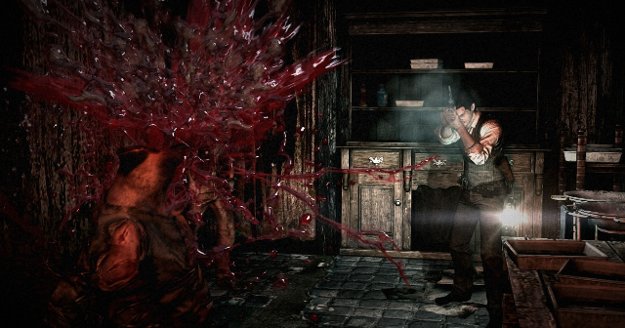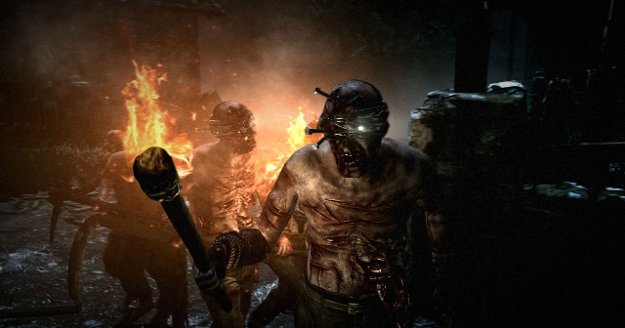To a horror aficionado, hearing that Shinji Mikami is working on another horror game is certainly cause for excitement, if not at least cautious optimism. Creator of Resident Evil 4, a game that can be called the catalyst of change in the survival-horror genre (arguably creating the over-the-shoulder perspective that would be used in many, many games from that point on), there's certainly reasons to look forward to what The Evil Within, his newest title, could bring. The result is...well, it's certainly different. A survival horror title that brings in other elements such as stealth and RPG-style progression elements, it stumbles more often than not, but creates an experience full of psychological twists and turns.
After a quick introduction to certain gameplay elements, it becomes pretty clear that the game doesn't really do a good job of dealing out the 'horror' part, mostly due to its disjointed nature. The plot starts out routine enough, involving an disturbance that Detective Castellanos, a generic tough-guy detective with grizzled look and gruff voice, responds to. Then things go straight-up crazy, and I'm not referring to the babbling lunatics trying to kill you. Locations will change with little rhyme or reason, placing you in a variety of areas that, while well-designed in their own right, fail at making you feel connected to the world around you.

One moment you're in an asylum, next you're in a sewer, then you're in a forest, before finding yourself in a hospital once more. While there are reasons as to why this actually happens, it makes the chapters of the game feel disjointed and completely out of order, like a shuffled deck of cards. The story doesn't really have much of a foothold in the game either, told very sparingly, with some pretty wooden characterization; I never really found myself caring about what, exactly, was going on.
There's also a feeling of peculiarity in the general atmosphere of the game. In one moment, you may be fleeing for your life from a terrifying, multi-limbed woman who is crawling along the ground to bash your head in. The next, you're wielding a weapon called the Agony Crossbow, firing bolts of exploding lightning at enemies wearing clay masks that block bullets. And when the most fear your character can muster is a annoyed "What the hell?", it's hard to really get into the mood of the game.

The Evil Within shares elements with numerous titles that Shinji Mikami has worked on in the past, notably third-person shooters such as Resident Evil 4 and Shadows of the Damned. A close (almost too close, Castellanos sometimes blocks far too much of the screen), over-the-shoulder camera and precision aiming with a small arsenal are there to help you cut through the enemies in your way, but Evil Within is a little bizarre with its gameplay, almost unsure of what it wants the player to do.
Through much of the first few chapters of the game, you're simply not well-equipped enough to take on the enemies that you confront, and it plays more like a stealth-based game, forcing you to keep out of lines of sight and take down enemies with stealth maneuvers, avoiding traps and hiding from groups. Mixed into this are areas where you're forced to hide or run from powerful bosses that can kill you pretty quickly. As the game progresses, however, this element of stealth is largely abandoned, except in some very rare occasions when enemies don't enter the world knowing exactly where you are. It became strange to come across a hiding place (such as a closet, or a bed to hide under) after a certain point, as there was simply no point to ever using it.

It's a little strange, too, given the game's high difficulty level - the first portion of the game saw me dying again and again as I simply got overwhelmed by enemies, hunted down by powerful foes, blown up by traps, or simply failing to be stealthy in any sense of the word. Ammo was scarce, enemies were tough, and it really felt like a survival-horror title. As the game went on, Castellanos was taking down entire rooms of enemies with nary a scratch, shooting exploding crossbow bolts and grenades willy-nilly (and yet still having melee attacks being 100% ineffectual). Still, the points where you're not taking down enemies left, right, and center feel like a return of atmosphere, where things feel tense and you're never quite sure if the shadow around the corner is something to be feared or not.
The upgrade system, at least, is enjoyable in its own right. Often, you'll come across something I dubbed 'brain goo', a green gel that is often in jars, sometimes in puddles dropped by enemies. This gel allows you to upgrade your abilities, weapons, and carrying capacities. It made exploring worthwhile, finding secrets a boon, and since there is so much to upgrade in the game, a sense of customization to your character that may be different from others'. However, like before, despite the game's insistence on having stealth elements, everything that can be upgraded simply makes Castellanos better at getting into scraps and getting out alive, not making him harder to detect or anything of the like. I liked the upgrade system, but it really makes that first stealth-filled section stand out as something from another game.

The Evil Within is a competent action-horror game, but one that doesn't quite know what it wants to be. The moment-to-moment action, quiet, or fear is presented well, but they just don't gel well together, creating a disjointing experience that's as fractured as the game's environments and atmosphere. Despite this, I enjoyed playing it, if only to get to the next section where I'd be running for my life, upgrading the good detective, or being presented with another crazy situation. As a whole, it falters heavily; as a collection of parts, it creates one heck of a weird, but fun, game to play.